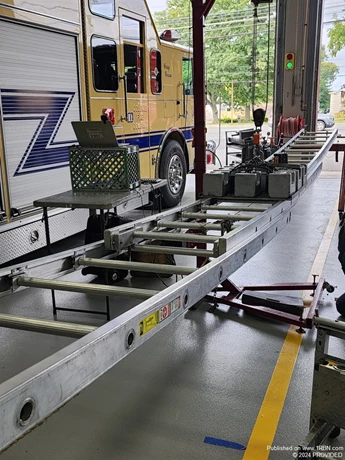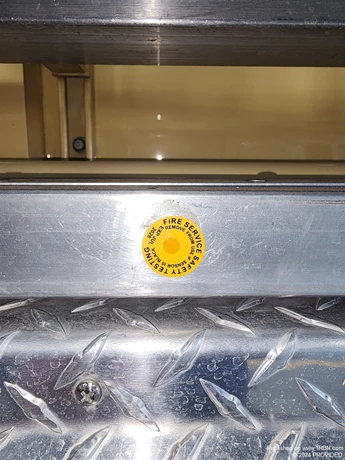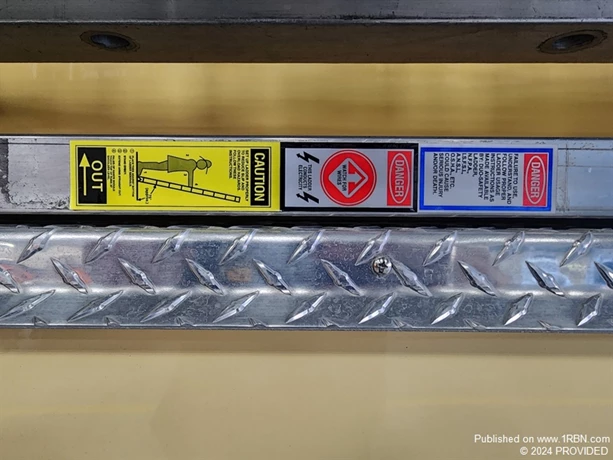Ladders


Photo by PROVIDEDExtension Ladder Testing

Photo by PROVIDEDHeat Sensor

Photo by PROVIDEDLadder Safety Info Label
Although not exactly the most glamorous tool or task, ladders are by far the most important supporting tool firefighters use. Instructing on the particulars of ladder use and maintenance can therefore be a challenging topic but again a necessary one for firefighting operations. The interesting part about teaching about ladders is that although there are some commonalities both in form and function each ladder type can be its own separate drill; that is how much information there is to cover. For example, you may group single, extension ladders together but you really can’t add in aerial ladders because they are so much different to operate.
Most fire companies carry several different types of ladders obviously due to the multitude of circumstances on the fireground. Each of course with different uses as illustrated in the table below which is by no means finite but presented here as a drill starting point.
As the instructor introduces each ladder type, they should go through the parts of each one. Using an extension ladder as an example an instructor would go over the base and fly sections, halyard, rungs, side rails, locks and feet. The physical attributes of a ladder can also generate mini drills. For example, tying a clove hitch on the halyard. The physical characteristics of a ladder can also include what material the ladder is made out of with wood, fiberglass and aluminum being the leading materials. Of course, each material having advantages and disadvantages.
Once an instructor has presented the types of ladders and their possible uses the next most logical step is to discuss the safety features on each ladder that should be included in any drill. More specifically the fire ladder label set and heat sensor labels. The instructor should emphasize the fact that once these safety features have been utilized (specifically the heat sensor) that the ladder must be taken out of service.
To further drive home the point of safety features an instructor can also expand the knowledge base by discussingNFPAstandards1931and1932. These standards dictate all the details of ladder testing including weight application and how often testing is to be completed. To summarize when ladders are “tested” they are placed on sawhorses with weights placed on them until they bend. Once the weight is removed the ladder should “snap” back to within a certain degree of its original form. If the ladder does not return to its original straightness or within an acceptable differential, then it must be removed from service.
What ladder drill would be complete without the application of motor skills. This of course refers to the different types of carries and raising. Probably the most important point to emphasize when carrying ladders are that the butt end of the ladder is always carried in the lead. This is so that the butt end can be placed against the building or house for more rapid deployment. The “butt firefighter” is therefore the one calling out instructions to lift, move and place the ladder.
The two basic ladder carries are the flat and shoulder carry. Regardless of which carry is used on the fireground or practiced in a drill the most important part is coordination between firefighters as they carry and/or raise the ladder. Remember the goal of throwing a ladder is to rescue a victim or provide egress for firefighters so there really isn’t room for error. Granted the fireground has that sense of urgency however, we practice like we work on the fireground and so efficiency is the key which means your efforts need to be coordinated.
As far as the type of carry and the number of firefighters necessary a good general rule is the first number of the ladder length. For example, if the ladder is 14 feet, then only one firefighter is necessary to carry it. If the ladder is 24 feet long then two firefighters should be used to carry that ladder. Regardless, of the length however one other of the finer points is that if three firefighters are used to carry a ladder to have the middle carry on the opposite side of the end firefighters. Also, every once in a while, as an instructor there is an inherently comedic skill. In the case of ladders picture a three firefighter carry with the middle firefighter shorter than the two end firefighters to the point where that middle firefighter cannot reach the ladder to provide any significant assistance.
The second most important point relates to raising a ladder and that is to make sure there are no obstacles overhead such as overhanging branches or especially power lines. A good instructor will emphasize calling out “clear overhead” EVERY TIME! This exclamation is often part of any test that firefighters need to demonstrate they have ladder skills down. Raising a ladder can be done one of two ways; the rung and beam method. The former uses the rungs to walk the ladder up and into position while the latter uses the beam to raise the ladder into position. Each way the ladder needs to be footed by either another firefighter or the base of the wall.
When the ladder is raised it is important to note that the fly section should be facing AWAY from the wall. That said, in a single firefighter raise the fly section initially faces the wall and then is flipped 180 degrees while using multiple firefighters has the fly section always facing away from the wall. Once vertical use the 4:1 ratio for setting the ladder. Generally, this works out to be a 75-degree angle and is tested by standing at the base and holding your arms straight out until the tips of your fingers can grasp the rung in front of you. A more concrete example would be a 24-foot ladder the base of the ladder should be about six feet from the base of the wall.
Last point would be that ladders have so many uses besides but one that has been taught to me and that I have passed along as an instructor is to use a ladder to transport tools. Think about this for a second, many volunteer departments will not have sufficient personnel for a given fire and so a single firefighter has a choice – either use a ladder to transport multiple tools such as hand tools, chainsaw, cutters edge etc. in one shot or run back and forth multiple times with several tools to the point you are spent and cannot assist any further.
As mentioned, a single article cannot provide all the finer points of ladder usage and deployment as there are so many other pieces of important information. That argument should be enough to convince any firefighter the importance of ladder use and deployment. However, the skills needed to be proficient in ladder usage are perishable and must be practiced continuously in order to be ready on the fireground.




